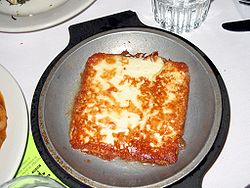food.wikisort.org - Dish
In Greek cuisine, saganaki (Greek σαγανάκι) is any one of a variety of dishes prepared in a small frying pan, the best-known being an appetizer of fried cheese.
 | |
| Course | Hors d'oeuvre |
|---|---|
| Place of origin | Greece |
| Variations | Many |
Etymology
|
The dishes are named for the frying pan in which they are prepared, called a saganaki, which is a diminutive of sagani, a frying pan with two handles, which comes from the Turkish word sahan 'copper dish',[1][2] itself borrowed from Arabic صحن (ṣaḥn).
Description
The cheese used in saganaki is usually graviera, kefalograviera, halloumi, kasseri,[3] kefalotyri,[3] or sheep's milk feta cheese. Regional variations include the use of formaela cheese in Arachova, halloumi in Cyprus, and vlahotiri in Metsovo. The cheese is melted in a small frying pan until it is bubbling and generally served with lemon juice and pepper. It is eaten with bread.[citation needed]
Other dishes cooked in a saganaki pan include shrimp saganaki (Greek: γαρίδες σαγανάκι, garídes saganáki), and mussels saganaki (Greek: μύδια σαγανάκι, mýdia saganáki), which are typically feta-based and include a spicy tomato sauce.[citation needed]
North American serving style
In many United States and Canadian restaurants, after being fried, the saganaki cheese is flambéed at the table (sometimes with a shout of "opa!"[4]), and the flames then usually extinguished with a squeeze of fresh lemon juice. This is called "flaming saganaki" and apparently originated in 1968 at the Parthenon restaurant in Chicago's Greektown,[5][6][7][8] based on the suggestion of a customer.[9]
See also
- Leipäjuusto
- List of hors d'oeuvre
- List of Greek dishes
- Saganaki cheese
- Smažený sýr
References
- Babiniotis, Λεξικό της Νέας Ελληνικής Γλώσσας
- Triantafyllidis, Λεξικό της κοινής Νεοελληνικής (Triantafyllidis Dictionary)
- Gayler, Paul (1998-09-15). A Passion for Cheese: More Than 130 Innovative Ways To Cook With Cheese. Macmillan. ISBN 978-0-312-19204-4.
- History
- The Parthenon: History
- "FAMOUS SAGANaKI ... and so much more". www.webcitation.org. Archived from the original on 2016-10-26. Retrieved 2016-11-08.
- "Exploring Chicago". University of Illinois at Chicago. Archived from the original on 2007-09-11. Retrieved 2007-09-23.
- Zeldes, Leah A (2002-09-30). "How to Eat Like a Chicagoan". Chicago's Restaurant Guide. Chicago's Restaurant Guide. Archived from the original on 2002-10-01. Retrieved 2002-09-30.
- Zeldes, Leah A. (Aug 27, 2009). "Opaa! Chicago Taste of Greece flies this weekend". Dining Chicago. Chicago's Restaurant & Entertainment Guide, Inc. Retrieved Aug 28, 2009.
На других языках
- [en] Saganaki
[ru] Саганаки
Саганаки (греч. Σαγανάκι) — традиционная греческая сырная закуска, которая жарится на сковороде или запекается на гриле.Другой контент может иметь иную лицензию. Перед использованием материалов сайта WikiSort.org внимательно изучите правила лицензирования конкретных элементов наполнения сайта.
WikiSort.org - проект по пересортировке и дополнению контента Википедии